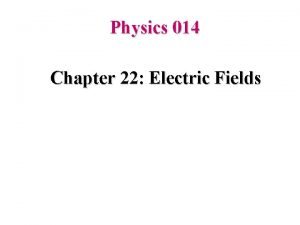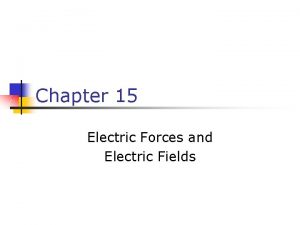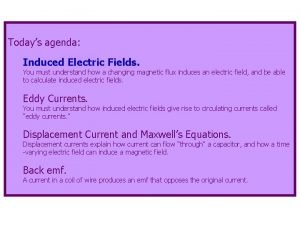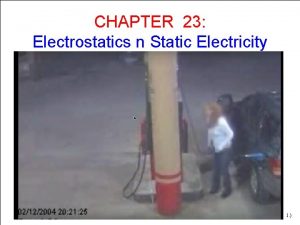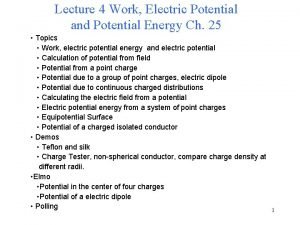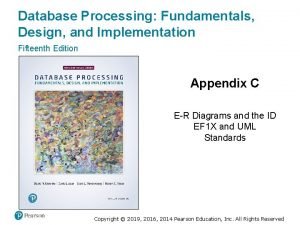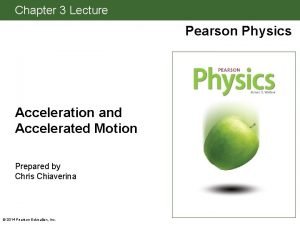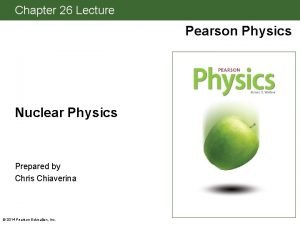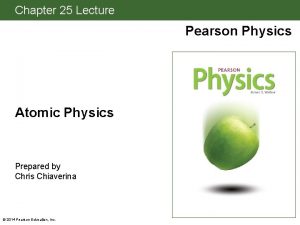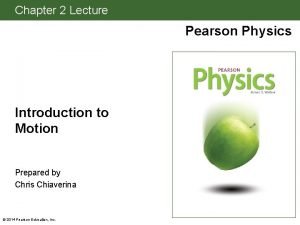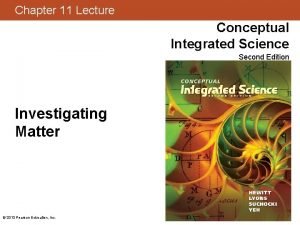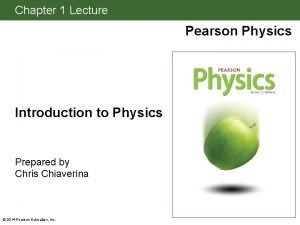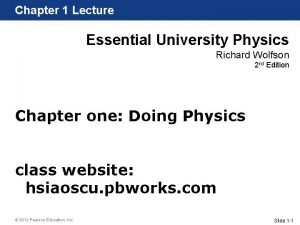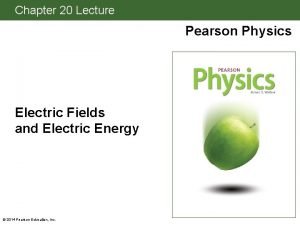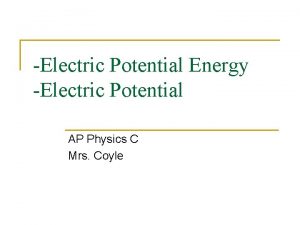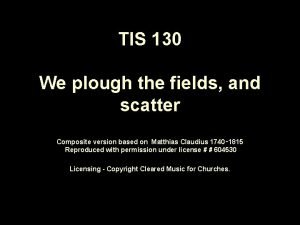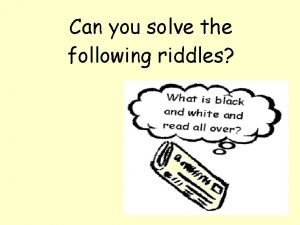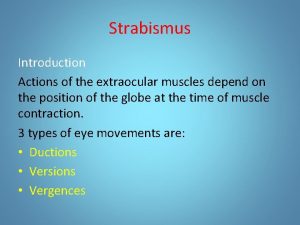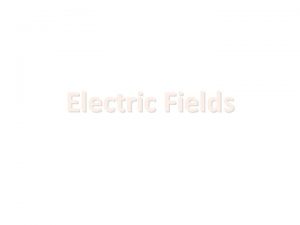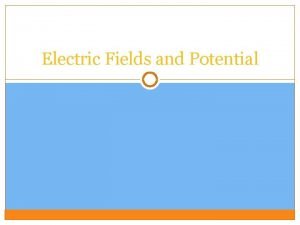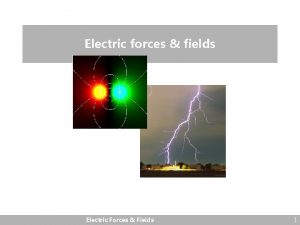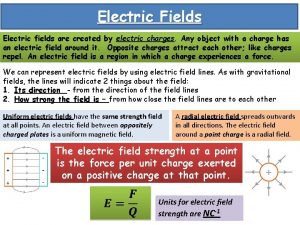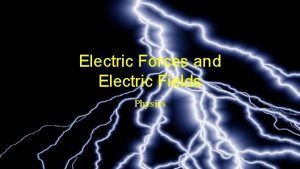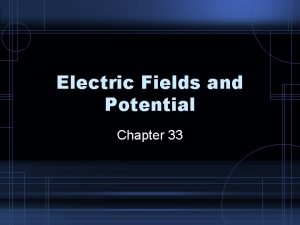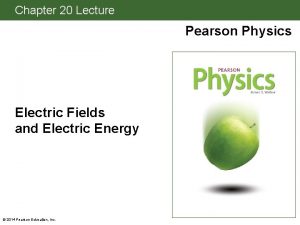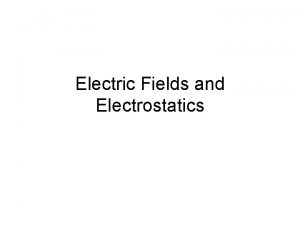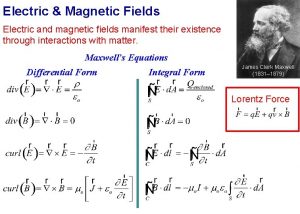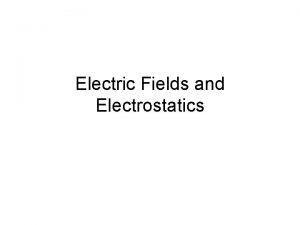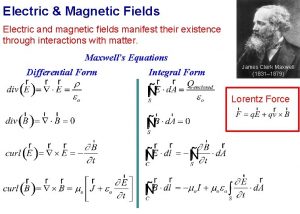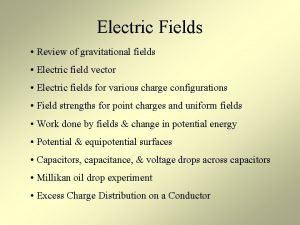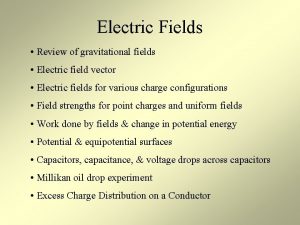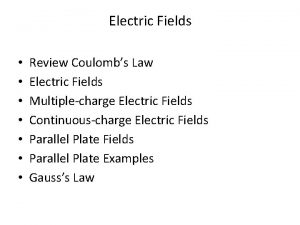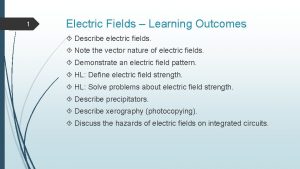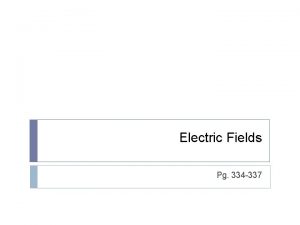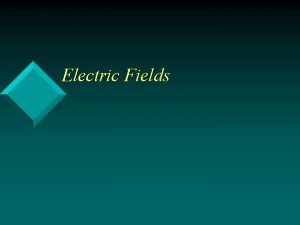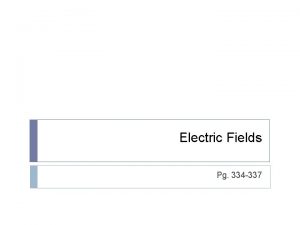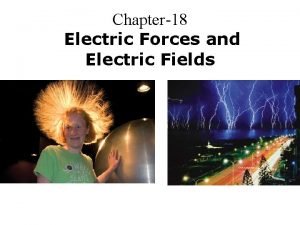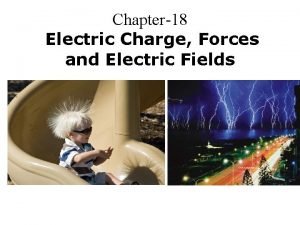Chapter 20 Lecture Pearson Physics Electric Fields and










































































- Slides: 74

Chapter 20 Lecture Pearson Physics Electric Fields and Electric Energy © 2014 Pearson Education, Inc.

Chapter Contents • The Electric Field • Electric Potential Energy and Electric Potential • Capacitance and Energy Storage © 2014 Pearson Education, Inc.

The Electric Field • An electrically charged object sets up a force field around it; this force field is known as an electric field. • To help visualize an electric field, look at a group of grass seeds suspended in a fluid (see figure below). © 2014 Pearson Education, Inc.

The Electric Field • In figure (a) there is no net electric charge, and hence no electric field. The seeds point in random directions. • In figure (b), the seeds line up in the direction of the electric field. Each seed experiences an electric force, and the force causes it to align with the field. • The standard way to draw electric fields is shown in the figure on the next slide. Here a positive charge +Q is shown at the center of figure (a) and a negative charge –Q is shown at the center of figure (b). © 2014 Pearson Education, Inc.

The Electric Field • The direction of an electric field is away from a positive charge and toward a negative charge. © 2014 Pearson Education, Inc.

The Electric Field • A small positive test charge (+q 0) at location A in the preceding figure experiences a force that is in the same direction as E. • A small negative test charge (−q 0) at location B experiences a weaker force (since it's farther away from the central charge) that is in the opposite direction from E. • Because the force on a positive charge is in the same direction as the electric field, we always use positive test charges to determine the direction of E. © 2014 Pearson Education, Inc.

The Electric Field • You've just seen the connection between the direction of the electric field and the direction of the electric force. How do we determine the magnitude of the electric field? • By definition, the magnitude of the electric field is the electric force per charge: © 2014 Pearson Education, Inc.

The Electric Field • In this definition it is assumed that the test charge is small enough that it does not disturb the position of any other charges in the system. • You will sometimes be given the electric field E at a given location and be asked to determine the force a charge q experiences at that location. This can be done as follows: © 2014 Pearson Education, Inc.

The Electric Field • The following example illustrates how the magnitude and direction of the force on a charge may be determined. © 2014 Pearson Education, Inc.

The Electric Field • Perhaps the simplest example of an electric field is the field produced by a point charge. Figure (a) below shows a point charge at the origin. • If a small test charge q 0 is placed at a distance r from the origin, the force it experiences is directed away from the origin and has a magnitude given by Coulomb's law: F = kq 1 q 0/r 2 © 2014 Pearson Education, Inc.

The Electric Field • Applying the definition of the electric field, E = F/q 0, we find that the magnitude of the electric field is E = F/q 0 = kq/r 2 • As you can see, the electric field due to a point charge decreases with the inverse square of the distance. In general, the electric field a distance r from a point charge q has the following magnitude: © 2014 Pearson Education, Inc.

The Electric Field • The electric field points away from a positive point charge. And as the figure below shows, the electric field points toward a negative point charge. © 2014 Pearson Education, Inc.

The Electric Field • The following example illustrates how the electric field due to a point charge is determined. © 2014 Pearson Education, Inc.

The Electric Field • The electric field due to a point charge decreases rapidly as the distance from the charge increases. The field never actually goes to zero, however. On the other hand, the electric field increases as the distance gets closer to zero. Thus, the closer you get to an electric charge, the stronger its electric field. © 2014 Pearson Education, Inc.

The Electric Field • When a system consists of several charges, the total electric field is found by superposition—that is, by calculating the vector sum of the electric fields due to the individual charges. • As an example, let's calculate the total electric field at point P due to two charges as shown in the figure below. © 2014 Pearson Education, Inc.

The Electric Field • The total electric field at the point P is the vector sum of the fields due to the charges q 1 and q 2. Notice that E 1 and E 2 point away from the charges q 1 and q 2, respectively and have the same magnitude, E: E = kq/r 2. • To find the total electric field, Etotal, we use components. • In the y direction, E 1, y = –E sinθ and E 2, y = +E sinθ. It follows that the y component of the total electric field is zero: Etotal, y = E 1, y + E 2, y = –E sinθ + E sinθ = 0 © 2014 Pearson Education, Inc.

The Electric Field • Similarly, we determine the x component of Etotal: Etotal, x = E 1, x + E 2, x = E cosθ + E cosθ = 2 E cosθ • Thus, the total electric field at P is in the positive x direction. The magnitude of the total electric field is equal to 2 E cosθ. © 2014 Pearson Education, Inc.

The Electric Field • A second example of how the total electric field is determined is given below. © 2014 Pearson Education, Inc.

The Electric Field • Many aquatic creatures are capable of producing electric fields. For example, some freshwater fish in Africa can use their specialized tail muscles to generate an electric field. They are also able to detect variations in this field as they move through their environment. This assists them in locating obstacles, enemies, and food. • Much stronger fields are produced by electric eels and electric skates. The electric eel Electrophorus electricus generates an electric field strong enough to kill small animals and to stun larger animals. © 2014 Pearson Education, Inc.

The Electric Field • The following set of rules provides a consistent method for drawing electric field lines: © 2014 Pearson Education, Inc.

The Electric Field • The following are examples of how these rules are applied. • In the figure below, the electric field lines all start at the positive charge, point radially outward, and go to infinity. In addition, the lines are closer together near the charge. © 2014 Pearson Education, Inc.

The Electric Field • The next figure shows the field produced by a charge of − 2 q. In this case, the direction of the field lines is reversed—they start at infinity and end on the negative charge. In addition, the number of lines is doubled, since the magnitude of the charge has been doubled. © 2014 Pearson Education, Inc.

The Electric Field • Electric fields tend to form specific patterns depending on the charges involved. A few such patterns, for various combinations of charges, are shown in the figure below. © 2014 Pearson Education, Inc.

The Electric Field • In figure (a), some field lines start on one charge and terminate on another. Notice also that the field lines are close together, indicating that the electric field is intense between the charges. • In contrast, the field is weak between the charges in figure (b), where the field lines are widely spaced. © 2014 Pearson Education, Inc.

The Electric Field • The charge combination of +q and –q in figure (c) is known as an electric dipole. The total charge of a dipole is zero, but because the positive and negative charges are separated, the electric field does not vanish. Instead, the field lines form loops that are characteristic of a dipole. • Dipoles are common in nature. Perhaps the most familiar example is the water molecule, which is positively charged at one end and negatively charged at the other. © 2014 Pearson Education, Inc.

The Electric Field • A simple but particularly important field picture results when charge is spread uniformly over a very large (essentially infinite) plate, as illustrated in the figure below. • The electric field is uniform in this case, in both direction and magnitude. The field points in a single direction—perpendicular to the plate. Most remarkably, the magnitude of the electric field doesn't depend on the distance from the plate. © 2014 Pearson Education, Inc.

The Electric Field • If two plates with opposite charge are placed parallel to each other and separated by a finite distance, the result is a parallel-plate capacitor. An example is shown in the figure below. • The field in this case is uniform between the plates and zero outside the plates. This case is ideal, which is exactly true for infinite plates and a good approximation for large plates. © 2014 Pearson Education, Inc.

The Electric Field • Conductors contain an enormous number of electrons that are free to move about. This simple fact has some rather interesting consequences. For one, any excess charge placed on a conductor moves to its outer surface, as is indicated in the figure below. © 2014 Pearson Education, Inc.

The Electric Field • In this way the individual charges are spread as far apart from one another as possible. • On a conducting sphere, excess charge placed on the sphere distributes itself uniformly on the surface. None of the excess charge is within the volume of the conductor. • The distribution of charge on the surface of a conductor guarantees that the electric field within the conductor is zero. This effect is referred to as shielding. Shielding occurs whether the conductor is solid or hollow. © 2014 Pearson Education, Inc.

The Electric Field • Shielding is put to use in numerous electrical devices, which often have a metal foil or wire mesh enclosure surrounding the sensitive electrical circuits. • Related to shielding is the fact that electric field lines always contact a conductor at right angles to its surface. In addition, the field lines crowd together where a conductor has point or a sharp projection, as illustrated in the following figure. The result is an intense electric field at a sharp metal point. © 2014 Pearson Education, Inc.

The Electric Field • The crowding of field lines at a point is the basic principle behind the operation of lightning rods. During an electrical storm the electric field at the tip of a lightning rod becomes so intense that electric charge is given off into the atmosphere. In this way a lightning rod discharges the area near the house, thus preventing lightning from striking the house, which would transfer a large amount of charge in one sudden blast. © 2014 Pearson Education, Inc.

The Electric Field • Because electric forces act a distance, it is possible to charge an object without touching it with a charged object. • The charging of an object without direct contact is referred to as charging by induction. • The following figure illustrates the steps involved in charging an object by induction. © 2014 Pearson Education, Inc.

The Electric Field • First, a negatively charged rod is brought close to the sphere as in figure (a). The charged rod induces positive and negative charge on opposite sides of the conducting sphere. At this point the sphere is still electrically neutral. © 2014 Pearson Education, Inc.

The Electric Field • The sphere is then grounded using a conducting wire [figure (b)]. Negative charges repelled by the rod enter the ground. (In general, grounding refers to the process of connecting a charged object to the Earth with a conductor and is indicated by the symbol. ) • With the charged rod still in place, the grounding wire is removed. This traps the net charge on the sphere [figure (c)]. • The charged rod is then removed. The sphere retains a charge with a sign that is opposite that on the charged rod [figure (d)]. © 2014 Pearson Education, Inc.

Electric Potential Energy and Electric Potential • Both electric and gravitational forces can store mechanical work in the form of potential energy. Mechanical work that is stored as electrical energy is referred to as electric potential energy. • Suppose you have a positive charge in one hand a negative charge in the other, as is shown in the figure below. © 2014 Pearson Education, Inc.

Electric Potential Energy and Electric Potential • Since the charges attract one another, you have to exert a force and do work to pull your hands apart. This work is stored in the electric field as electric potential energy. • If you release the charges, they speed up as they race toward each other, converting their electric potential energy into kinetic energy. © 2014 Pearson Education, Inc.

Electric Potential Energy and Electric Potential • If they charges are both positive, they will repel one another. Moving two charges that repel each other closer together requires mechanical work. This work will be stored as electric potential energy, as is shown in the figure below. If the charges are released, they fly apart from one another, converting electric potential energy to kinetic energy. © 2014 Pearson Education, Inc.

Electric Potential Energy and Electric Potential • A positive charge q placed in the uniform electric field E shown in the figure below experiences a downward electric force of magnitude F = q. E. • If the charge is moved upward through a distance d, the electric force and the displacement are in opposite directions. Therefore, the work done by the electric force is negative and equal in magnitude to the force times distance: W = −q. Ed. © 2014 Pearson Education, Inc.

Electric Potential Energy and Electric Potential • From the equation that relates work and potential energy, ΔPE = −W, we see that the system's change in electric potential energy is given by ΔPE = −W or ΔPE = q. Ed. • Notice that the electric potential energy increases in this case. This is like increasing the gravitational potential energy by raising a ball against the force of gravity, as is indicated in the figure below. © 2014 Pearson Education, Inc.

Electric Potential Energy and Electric Potential • Suppose the electrical potential energy of a charge q changes by the amount ΔPE. By definition, we say that the electric potential, V, of the charge changes by the amount PE/q. • The electric potential is basically electric potential energy per charge. The electric potential is generally referred to as voltage because it is measured in a unit called the volt. © 2014 Pearson Education, Inc.

Electric Potential Energy and Electric Potential • You are probably familiar with voltage in the form of 120 -V electricity in your home or 1. 5 -V batteries for your camera. • The volt is named in honor of Alessandro Volta (1745– 1827), who invented a predecessor to the modern battery. The volt has the units of energy (J) per charge (C): 1 V = 1 J/C • Equivalently, 1 joule of energy is equal to 1 coulomb times 1 volt: 1 J = (1 C)(1 V) © 2014 Pearson Education, Inc.

Electric Potential Energy and Electric Potential • It follows that a 1. 5 -V battery does 1. 5 J of work for every coulomb of charge that flows through it; that is, (1 C)(1. 5 V) = 1. 5 J. In general, the change in electric potential energy, ΔPE, as a charge q moves through an electric potential (voltage) difference ΔV is ΔPE = qΔV. • The following example illustrates how the change in electric potential energy is found. © 2014 Pearson Education, Inc.

Electric Potential Energy and Electric Potential © 2014 Pearson Education, Inc.

Electric Potential Energy and Electric Potential • In general, a high-voltage system has a lot of electric potential energy. The figure below shows the situation for charges of opposite sign. When the charges are widely separated, the voltage is high. If these charges are released, a lot of electrical energy is converted into kinetic energy. © 2014 Pearson Education, Inc.

Electric Potential Energy and Electric Potential • For the case of charges with the same sign, like those in the figure below, the situation is reversed. Charges close together correspond to high voltage because they fly apart at high speed when released. © 2014 Pearson Education, Inc.

Electric Potential Energy and Electric Potential • There is a straightforward and useful connection between the electric field and electric potential. • To obtain this relationship, we will apply the definition ΔV = ΔPE/q to the case of a charge that moves through a distance d in the direction of the electric field, as is shown in the figure below. © 2014 Pearson Education, Inc.

Electric Potential Energy and Electric Potential • The work done by the electric field in this case is simply the magnitude of the electric force F = Eq, times the distance, d: W = q. Ed • Therefore, the change in electric potential is ΔV = ΔPE/q = −W/q = −(q. Ed)/q = −Ed • Solving for the electric field, we find the following: © 2014 Pearson Education, Inc.

Electric Potential Energy and Electric Potential • To summarize, the electric field depends on the rate of change of the electric potential with position. In terms of a gravitational analogy, you can think of the electric potential, V, as the height of the hill and the electric field, E, as the slope of the hill. This analogy is illustrated in the figure below. © 2014 Pearson Education, Inc.

Electric Potential Energy and Electric Potential • As the figure below illustrates, the electric potential decreases in the direction of the electric field. In addition, the electric potential doesn't change at all in the direction perpendicular to the electric field. • For the case shown, the electric field is constant. As a result, the electric potential decreases uniformly with distance. © 2014 Pearson Education, Inc.

Electric Potential Energy and Electric Potential • The following example illustrates how (a) the electric field in a capacitor can be determined and (b) how the change in electric potential energy of a charge moved between the plates of the capacitor can be calculated. © 2014 Pearson Education, Inc.

Electric Potential Energy and Electric Potential • Energy conservation applies to a charged object in an electric field. As a result, the sum of the object's kinetic and electric potential energies must be the same at any two points, say A and B: ½mv. A 2 + PEA = ½mv. B 2 + PEB • This equation applies to any conservative force. Notice, however, that the PE term in the equation depends on the type of conservation force involved. © 2014 Pearson Education, Inc.

Electric Potential Energy and Electric Potential • For a uniform gravitational field, the potential energy is PE = mgy. • For an ideal spring, the potential energy is PE = ½kx 2. • For an electrical system, the potential energy is PE = q. V. © 2014 Pearson Education, Inc.

Electric Potential Energy and Electric Potential • Charges that are free to move in an electric field will accelerate. – Positive charges accelerate in the direction of decreasing electric potential. – Negative charges accelerate in the direction of increasing electric potential. • In both cases, the charge moves to a region of lower electric potential energy—like a ball rolling downhill to a position where it has lower gravitational potential energy. © 2014 Pearson Education, Inc.

Electric Potential Energy and Electric Potential • We have learned that the electric field a distance r from a point charge is given by E = kq/r 2 • Similarly, it can be shown that the electric potential at a distance r from a point charge is the following: © 2014 Pearson Education, Inc.

Electric Potential Energy and Electric Potential • Notice that the electric potential is zero at an infinite distance, r = ∞. Also, the potential is positive for a positive charge and negative for a negative charge. • The electric potential is a number (scalar) and therefore it has no associated direction. • If a charge q 0 is in a location where the potential is V, the corresponding electric potential energy is PE = q 0 V © 2014 Pearson Education, Inc.

Electric Potential Energy and Electric Potential • For the special case where the electric potential is due to a point charge q, the electric potential energy is as follows: © 2014 Pearson Education, Inc.

Electric Potential Energy and Electric Potential • The following example illustrates how the potential of a point charge is determined. © 2014 Pearson Education, Inc.

Electric Potential Energy and Electric Potential • As mentioned earlier, the sign of the electric potential V depends on the sign of the charge in question. This relationship is illustrated in the figure below. © 2014 Pearson Education, Inc.

Electric Potential Energy and Electric Potential • The figure shows the electric potential near (a) a positive charge and (b) a negative charge. In the case of the positive charge, the potential forms a potential hill. The negative charge produces a potential well. • Like many physical quantities, the electric potential obeys a simple superposition principle. Therefore, the total electric potential due to two or more charges is equal to the algebraic sum of the potentials due to the individual charges. • The algebraic sign of each potential must be taken into account. © 2014 Pearson Education, Inc.

Capacitance and Energy Storage • A common way for electrical systems to store energy is in a device known as a capacitor. • A capacitor gets its name from the fact that it has a capacity to store both electric charge and electrical energy. • Capacitors are an important element in modern electronic devices. No cell phone or computer could work without capacitors. © 2014 Pearson Education, Inc.

Capacitance and Energy Storage • In general, a capacitor is nothing more than two conductors, referred to as plates, separated by a finite distance. • When the plates of a capacitor are connected to the terminals of a battery, they become charged. One plate acquires a positive charge, +Q, and the other plate acquires an equal and opposite negative charge, −Q. © 2014 Pearson Education, Inc.

Capacitance and Energy Storage • To be specific, suppose a certain battery produces a potential difference (or voltage) V between its terminals. When this battery is connected to a capacitor, a charge of magnitude Q appears on each plate. • The ratio of the charge stored to the applied voltage—that is, the ratio Q/V—is called the capacitance, C. • The greater the charge Q for a given voltage V, the greater the capacitance of the capacitor. © 2014 Pearson Education, Inc.

Capacitance and Energy Storage • Summarizing, • In this equation, Q is the magnitude of the charge on either plate and V is the magnitude of the voltage difference between plates. By definition, the capacitance is always a positive quantity. © 2014 Pearson Education, Inc.

Capacitance and Energy Storage • From the relation C = Q/V we see that the units of capacitance are coulombs per volt. In the SI system this combination of units is referred to as the farad (F), in honor of the English physicist Michael Faraday (1791– 1867). In particular, 1 F = 1 C/V • Just as the coulomb is a rather large unit of charge, so too is the farad a rather large unit of capacitance. Typical values for capacitance are in the picofarad (1 p. F = 10− 12 F) to microfarad (1 µF = 10− 6 F) range. © 2014 Pearson Education, Inc.

Capacitance and Energy Storage • A bucket of water provides a useful analogy when thinking about capacitors, as shown in the figure below. © 2014 Pearson Education, Inc.

Capacitance and Energy Storage • For this analogy we make the following identifications: – The cross-sectional area of the bucket is the capacitance, C. – The amount of water in the bucket is the charge, Q. – The depth of the water is the potential difference, V, between plates. © 2014 Pearson Education, Inc.

Capacitance and Energy Storage • In terms of this analogy, charging a capacitor is like pouring water into a bucket. If the capacitance is large, it's like having a wide bucket. In this case, the bucket holds a lot of water when it has a given level of water. A narrow bucket with the same water level holds much less water. This can be seen in the figure below. © 2014 Pearson Education, Inc.

Capacitance and Energy Storage • Similarly, a capacitor with a large capacitance holds a lot of charge (water) for a given applied voltage (water level). • The following example illustrates how the relationships C = Q/V and E = −ΔV/d may be applied. © 2014 Pearson Education, Inc.

Capacitance and Energy Storage • The two main factors that determine the capacitance of a capacitor are plate area and plate separation. • If the area of the plates is increased, the capacitance goes up. It's just like the analogy with a bucket of water—a capacitor with a large plate area is like a bucket with a large crosssectional area. © 2014 Pearson Education, Inc.

Capacitance and Energy Storage • If the plate separation is decreased, the capacitance increases. The reason is that a smaller separation between plates reduces the potential difference between them. This means that less voltage is required to store a given amount of charge—which is another way of saying that the capacitance is larger. © 2014 Pearson Education, Inc.

Capacitance and Energy Storage • The dependence of capacitance on plate separation is useful in a number of interesting applications. • Each key on a computer keyboard is connected to the upper plate of a parallel plate capacitor, as illustrated in the figure below. • When you press on a key, the separation between the plates of the capacitor decreases. This increases the capacitance of the key. The circuitry of the computer detects this change in capacitance and determines which key has been pressed. © 2014 Pearson Education, Inc.

Capacitance and Energy Storage • As mentioned before, capacitors store more than just charge—they also store energy. It can be shown that the total energy, PE, stored in a capacitor with charge Q and potential difference V is PE = ½QV • Therefore, increasing a capacitor's charge or voltage increases its stored energy. © 2014 Pearson Education, Inc.

Capacitance and Energy Storage • The energy stored in a capacitor can be put to a number of practical uses. • A camera's flash unit typically contains a capacitor with a capacitance of about 400 µF. When fully charged to a voltage of 300 V, this capacitor contains roughly 15 J of energy. Because of the rapid release of energy— discharge takes less than a millisecond—the power output of a flash unit is impressively large—about 10– 20 k. W. © 2014 Pearson Education, Inc.

Capacitance and Energy Storage • A defibrillator uses a capacitor to deliver a shock to a person's heart, restoring it to normal function. Capacitors can have the opposite effect as well. It is for this reason that they can be quite dangerous, even in electrical devices that are turned off and unplugged from the wall. • For example, a typical TV set or computer monitor contains a number of capacitors. Some of these capacitors store a significant amount of charge for a long period of time. If you reach into the back of an unplugged television set, there is a danger that you might come in contact with the terminals of a capacitor, resulting in a shock. © 2014 Pearson Education, Inc.
 Chapter 16: electric forces and fields answers
Chapter 16: electric forces and fields answers Chapter 33 electric fields and potential
Chapter 33 electric fields and potential Red fields
Red fields Chapter 21 study guide electric fields answers
Chapter 21 study guide electric fields answers Chapter 22 electric fields
Chapter 22 electric fields Electric forces and fields concept review
Electric forces and fields concept review Electric currents and magnetic fields
Electric currents and magnetic fields Visualizing magnetic field
Visualizing magnetic field Chapter 21 electric charge and electric field
Chapter 21 electric charge and electric field Chapter 21 electric charge and electric field
Chapter 21 electric charge and electric field Electric field k constant
Electric field k constant Dc o/d per item charge
Dc o/d per item charge Electric fields quiz
Electric fields quiz Electric fields
Electric fields Electric fields
Electric fields Induced electric field in a solenoid
Induced electric field in a solenoid 01:640:244 lecture notes - lecture 15: plat, idah, farad
01:640:244 lecture notes - lecture 15: plat, idah, farad Conceptual physics chapter 35 electric circuits
Conceptual physics chapter 35 electric circuits Conceptual physics chapter 23 electric current
Conceptual physics chapter 23 electric current Electric potential formula physics
Electric potential formula physics Electric potential is
Electric potential is Potential due to an electric dipole
Potential due to an electric dipole Electric charges and electric forces lesson outline
Electric charges and electric forces lesson outline Electric potential lecture
Electric potential lecture Physics 102
Physics 102 2011 pearson education
2011 pearson education 2011 pearson education inc
2011 pearson education inc Bob whelan pearson
Bob whelan pearson Stress management for life 5th edition
Stress management for life 5th edition Pearson education inc publishing as pearson prentice hall
Pearson education inc publishing as pearson prentice hall Pearson education inc. 2012
Pearson education inc. 2012 2008 pearson prentice hall inc
2008 pearson prentice hall inc Electric potential vs electric potential energy
Electric potential vs electric potential energy A suitable electric pump in an electric circuit is a
A suitable electric pump in an electric circuit is a Classical mechanics
Classical mechanics Physics 101 lecture
Physics 101 lecture Physics 101 lecture 1
Physics 101 lecture 1 Physics 101 lecture notes pdf
Physics 101 lecture notes pdf What is wave motion
What is wave motion Atmospheric physics lecture notes
Atmospheric physics lecture notes Database processing fundamentals design and implementation
Database processing fundamentals design and implementation Pearson physics
Pearson physics Pearson physics
Pearson physics Chain physics
Chain physics Pearson physics
Pearson physics Constant velocity position time graph
Constant velocity position time graph Conceptual integrated science
Conceptual integrated science Pearson physics
Pearson physics Pearson physics
Pearson physics Pearson physics
Pearson physics Permanent and induced magnets bbc bitesize
Permanent and induced magnets bbc bitesize Ap physics c electric potential
Ap physics c electric potential Modern physics vs classical physics
Modern physics vs classical physics University physics with modern physics fifteenth edition
University physics with modern physics fifteenth edition Ib physics ia ideas mechanics
Ib physics ia ideas mechanics We plow the fields and scatter
We plow the fields and scatter Rodan and fields tax write offs
Rodan and fields tax write offs Learning: module 26: magnetic forces and fields
Learning: module 26: magnetic forces and fields Lesson outline magnets and magnetic fields answer key
Lesson outline magnets and magnetic fields answer key You can find me in darkness but never in light
You can find me in darkness but never in light What is displacement current
What is displacement current 3 branches of psychology
3 branches of psychology Multiplicative inverse
Multiplicative inverse Chapter 17 section 1 electric charge and force answer key
Chapter 17 section 1 electric charge and force answer key Management fifteenth edition
Management fifteenth edition Human resources management chapter 1
Human resources management chapter 1 Human resource management lecture chapter 1
Human resource management lecture chapter 1 Norm rule fields
Norm rule fields How many fields in computer science
How many fields in computer science Fremitus lungs
Fremitus lungs Latent squint meaning
Latent squint meaning 6 cardinal fields of gaze
6 cardinal fields of gaze Stealing poem
Stealing poem Slope fields ap calculus
Slope fields ap calculus Mips fields
Mips fields




